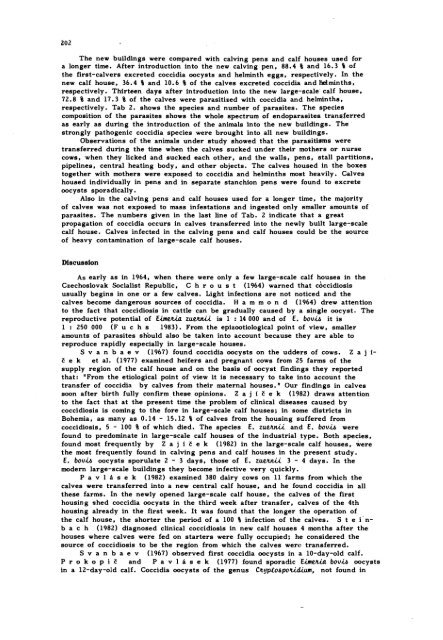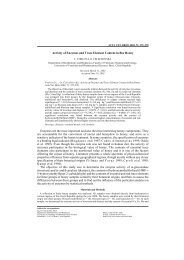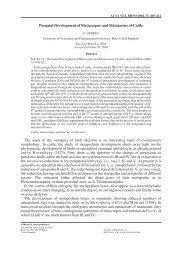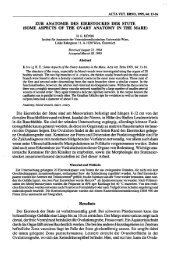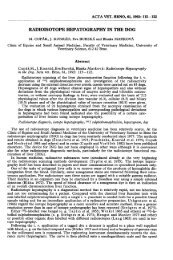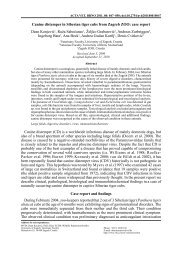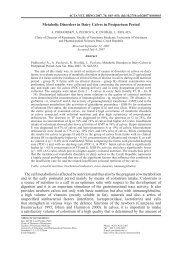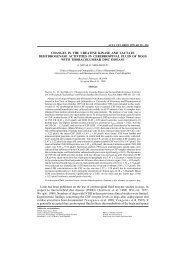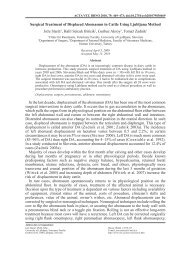Full text - Acta Veterinaria Brno
Full text - Acta Veterinaria Brno
Full text - Acta Veterinaria Brno
Create successful ePaper yourself
Turn your PDF publications into a flip-book with our unique Google optimized e-Paper software.
202<br />
The new buildings were compared with calving pens and calf houses used for<br />
a longer time. After introduction into the new calving pen, 88.4 % and 16.3 % of<br />
the first-calvers excreted coccidia oocysts and helminth eggs, respectively. In the<br />
new calf house, 36.4 % and 10.6 % of the calves excreted coccidia and he!.minths,<br />
respectively. Thirteen day·. after introduction into the new large-scale calf house,<br />
7Z.8 % and 17.3 % of the calves were parasitized with coccidia and helminths,<br />
respectively. Tab 2. shows the species and number of parasites. The species<br />
composition of the parasites shows the whole spectrum of endoparasites tran.ferred<br />
as early as during the introduction of the animals into the new buildings. The<br />
strongly pathogenic coccidia species were brought into all new buildings.<br />
Observations of the animals under study showed that the parasitisms were<br />
transferred during the time when the calves sucked under their mothers or nurse<br />
cows ,when they licked and sucked each other, and the walls, pens, stall . partitions,<br />
pipelines, central heating body, and other objects. The calves housed in the boxes<br />
together with mothers were exposed to coccidia and helminths most heavily. Calves<br />
housed individually in pens and in separate stanchion pens were found to excrete<br />
oocysts sporadically.<br />
Also in the calving pens and calf houses used for a longer time, the majority<br />
of calves was not exposed to mass infestations and ingested only smaller amounts of<br />
parasites. The numbers given in the last line of Tab. 2 indicate that a great<br />
propagation of coccidia occurs in calves transferred into the newly built large-scale<br />
calf house. Calves infected in the calving pens and calf houses could be the source<br />
of heavy contamination of large-scale calf houses.<br />
Discussion<br />
As early as in 1964, when there were only a few large-scale calf houses in the<br />
Czechoslovak Socialist Republic, C h r 0 u s t (1964) warned that c6ccidiosis<br />
usually begins in one or a few calves. Light infections are not noticed and the<br />
calves become dangerous sources of coccidia. Ham m 0 n d (1964) drew attention<br />
to the fact that coccidiosis in cattle can be gradually caused by a single oocyst. The<br />
reproductive potential of EUflvUo. zueJUt.U is 1 : 14000 and of E. bov,u it is<br />
1 : 250 000 (F u c h s 1983). From the epizootiological point of view, smaller<br />
amounts of parasites should also be taken into account because they are able to<br />
reproduce rapidly especially in large-scale houses.<br />
5 van b a e v (1967) found coccidia oocysts on the udders of cows. Z a j I<br />
e e k et al. (1977) examined heifers and pregnant cows from 25 farms of the<br />
supply region of the calf house and on the basis of oocyst findings they reported<br />
that: "From the etiological point of view it is necessary to take into account the<br />
transfer of coccidia by calves from their maternal houses." Our findings in calves<br />
soon after birth fully confirm these opinions. Z a j lee k (1982) draws attention<br />
to the fact that at the present time the problem of clinical diseases caused by<br />
coccidiosis is coming to the fore in large-scale calf houses; in some districts in<br />
Bohemia, as many as 0.14 - 15.12 % of calves from the housing suffered from<br />
coccidiosis, 5 - 100 % of which died. The species E. zUeJln-U and E. bov,u were<br />
found to predominate in large-scale calf houses of the industrial type. Both species,<br />
found most frequently by Z a j lee k (1982) in the large-scale calf houses, were<br />
the most frequently found in calving pens and calf houses in the present study.<br />
E. bov,u oocysts sporUlate 2 - 3 days, those of E. zueJUt.U 3 - 4 days. In the<br />
modern large-scale buildings they become infective very quickly.<br />
P a v I a s e k (1982) examined 380 dairy cows on 11 farms from which the<br />
calves were transferred into a new central calf house, and he found coccidia in all<br />
these farms. In the newly opened large-scale calf house, the calves of the first<br />
housin g shed coccidia oocysts in the third week after transfer, calves of the 4th<br />
housing already in the first week. It was found that the longer the operation of<br />
the calf house, the shorter the period of a 100 % infection of the calves. 5 t e i' n<br />
b a c h (1982) diagnosed clinical coccidiosis in new calf houses 4 months after the<br />
houses where calves were fed on starters were fully occupied; he considered the<br />
source. of coccidiosis to be the region from which the calves wert) transferred.<br />
5 van b a e v (1967) observed first coccidia oocysts in a 10-day-old calf.<br />
Pro k 0 pic and P a v I a s e k (1977) found sporadic EimvUo. bov,u oocysts<br />
in a 12-day-old calf. Coccidia oocysts of the genus C1t!fpto4poucLiwn, not found in


